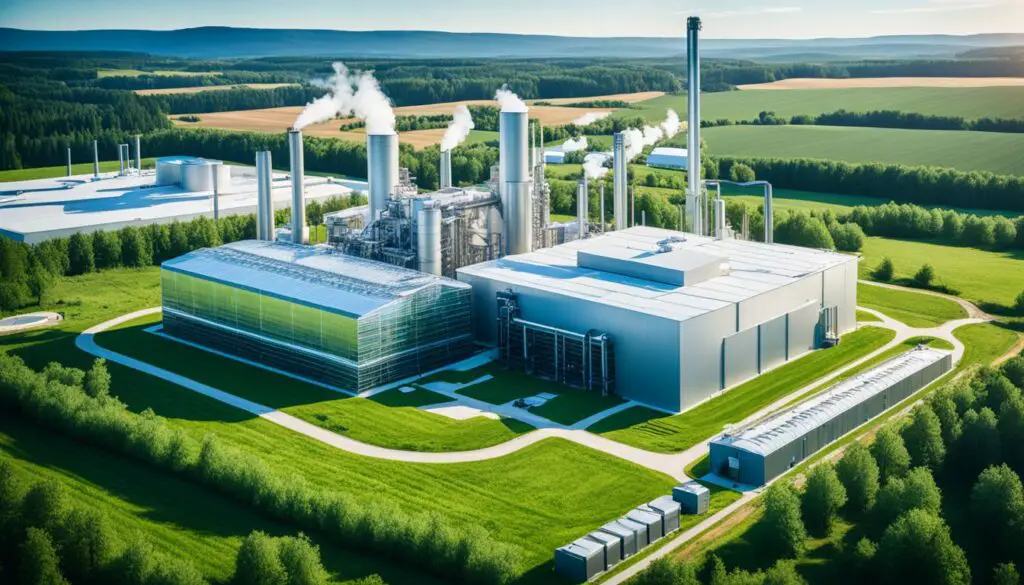As we strive towards a more sustainable future, it is crucial to monitor and track our greenhouse gas emissions effectively. This is where the power of artificial intelligence (AI) comes into play. AI has revolutionized our approach to greenhouse gas tracking, offering advanced data analysis and processing capabilities that enable more accurate and efficient monitoring of emissions.
With AI algorithms, we can analyze large amounts of data in real-time, gaining valuable insights and identifying trends and patterns. This allows us to pinpoint emission sources and take prompt actions to reduce our carbon footprint. AI also helps in the development of predictive models, enabling us to forecast future emissions and make informed decisions to mitigate climate change.
By leveraging AI technology, we can track greenhouse gas emissions more effectively, identify areas for improvement, and work towards a cleaner and greener planet. The use of AI in greenhouse gas monitoring is not only vital for environmental conservation but also contributes to creating a sustainable and livable future for generations to come.
Key Takeaways:
- AI revolutionizes greenhouse gas tracking and monitoring emissions.
- Advanced data analysis and processing capabilities enable more accuracy and efficiency.
- Real-time analysis provides valuable insights and identifies emission trends and patterns.
- AI aids in the development of predictive models for forecasting future emissions.
- Leveraging AI technology helps in reducing our carbon footprint and creating a sustainable future.
Enhancing Bioenergy Production with Digital Technologies
Biomass, derived from organic materials such as agriculture and forestry waste, has great potential as a renewable energy source in the form of bioenergy. A recent study by researchers from the Polytechnic Institute of Viseu highlighted the role of digital technologies in optimizing and predicting bioenergy production from biomass.
By leveraging the power of AI algorithms, such as neural networks and decision trees, we can enhance the conversion of biowaste into bioenergy, consequently improving efficiency and addressing challenges like feedstock variability and conversion costs. These digital technologies provide us with the tools to analyze vast amounts of data and optimize the entire process of bioenergy production.
The integration of digital technologies into bioenergy systems goes beyond improving efficiency. It also enhances resilience by providing AI-driven monitoring systems to manage agricultural inputs and improve production forecasts. These advancements not only streamline the production process but also contribute to environmental sustainability by reducing waste and promoting the efficient use of resources.
“The utilization of digital technologies is transforming the bioenergy sector, enabling us to unlock its full potential and drive the transition to a circular bioeconomy,” says Dr. Maria Silva, lead researcher at the Polytechnic Institute of Viseu.
By harnessing the power of digital technologies, we can make bioenergy a more efficient and sustainable energy source. The advancements in AI and data-driven optimization techniques allow us to overcome the limitations of traditional bioenergy production methods. With these technologies, we can maximize the use of biomass resources, minimize waste, and contribute to a cleaner and more sustainable future.
| Benefits of Enhancing Bioenergy Production with Digital Technologies | Key Features |
|---|---|
| Improved efficiency | – Optimization of the conversion process – Reduction of feedstock variability and associated costs |
| Enhanced resilience | – AI-driven monitoring systems for managing agricultural inputs – Improved production forecasts |
| Promotion of sustainability | – Efficient use of biomass resources – Minimization of waste |
With the continuous advancements in digital technologies, the bioenergy sector is poised for significant growth and innovation. By embracing these tools and optimizing bioenergy production, we can accelerate the transition to a sustainable future and reduce our reliance on fossil fuels.

Policy and Legislative Developments in Climate Mitigation
The U.S. House recently approved the Atomic Energy Advancement Act, a bipartisan bill aimed at accelerating the approval process for new nuclear plants. This significant development supports the expansion of nuclear energy as a low-carbon power source, contributing to the overall reduction of greenhouse gas emissions.
In Spain, crucial steps are being taken towards the development of offshore wind plants. Currently, there is an open consultation period focused on establishing new rules and programs to produce 3 gigawatts of offshore wind energy by 2030. This ambitious initiative showcases Spain’s commitment to renewable energy and greenhouse gas reduction.
Colorado’s Greenhouse Gas Pollution Reduction Roadmap is a clear demonstration of the state’s dedication to achieving its emissions reduction goals. The roadmap highlights the progress made thus far, projecting that Colorado will be over 80% of the way to a 50% reduction by 2030. This comprehensive plan sets a solid foundation for further greenhouse gas reduction efforts.
As part of their climate-reporting rule, the U.S. Securities and Exchange Commission (SEC) has announced plans to eliminate the mandatory reporting of Scope 3 emissions for publicly traded companies. This adjustment to the SEC reporting requirement streamlines the reporting process and allows companies to focus on implementing effective greenhouse gas reduction strategies.
FAQ
How does AI play a role in greenhouse gas tracking and monitoring emissions?
AI plays a crucial role in revolutionizing our approach to greenhouse gas tracking and monitoring emissions. It offers advanced data analysis and processing capabilities, allowing for more accurate and efficient monitoring of greenhouse gas emissions. With the help of AI algorithms, large amounts of data can be analyzed in real-time, providing valuable insights and identifying trends and patterns. AI can also aid in the development of predictive models, enabling us to forecast future emissions and make informed decisions to mitigate climate change.
What is the potential of biomass as a renewable energy source?
Biomass, derived from organic materials such as agriculture and forestry waste, has great potential as a renewable energy source in the form of bioenergy. A recent study by researchers from the Polytechnic Institute of Viseu highlighted the role of digital technologies in optimizing and predicting bioenergy production from biomass. AI algorithms, such as neural networks and decision trees, have been used to enhance the conversion of biowaste to bioenergy, improving efficiency and addressing challenges like feedstock variability and conversion costs. The integration of digital technologies into bioenergy systems also enhances resilience by providing AI-driven monitoring systems to manage agricultural inputs and improve production forecasts.
What recent policy and legislative developments are relevant to climate mitigation?
The U.S. House approved the Atomic Energy Advancement Act, a bipartisan bill that accelerates the approval process for new nuclear plants, supporting the expansion of nuclear energy as a low-carbon power source. Spain is also taking steps towards the development of offshore wind plants, with a consultation period open for new rules and programs aimed at producing 3 gigawatts of offshore wind energy by 2030. Additionally, Colorado’s Greenhouse Gas Pollution Reduction Roadmap highlights the state’s progress towards its emissions reduction goal, projecting to be over 80% of the way to a 50% reduction by 2030. On the other hand, the U.S. Securities and Exchange Commission plans to drop the mandatory reporting of Scope 3 emissions for publicly traded companies from its climate-reporting rule. Furthermore, the corporate sustainability due diligence directive (CSDDD) in the European Union, aimed at addressing companies’ negative impact on the environment and human rights, failed to pass.
Source Links
- https://www.economist.com/letters/2024/03/01/the-best-strategy-over-the-next-two-decades-is-to-cut-methane
- https://naturalsciencenews.com/article/364
- https://www.greenbiz.com/article/week-climate-policy-6-updates-you-need-know








